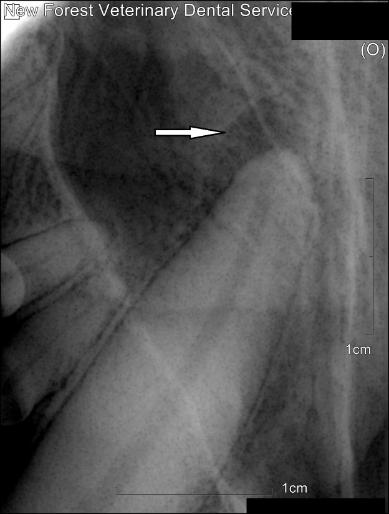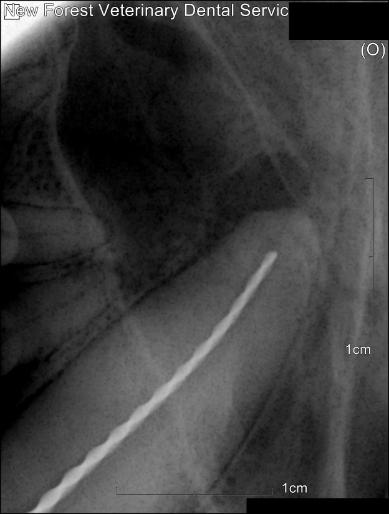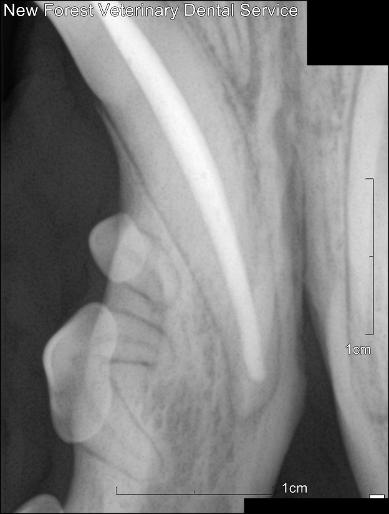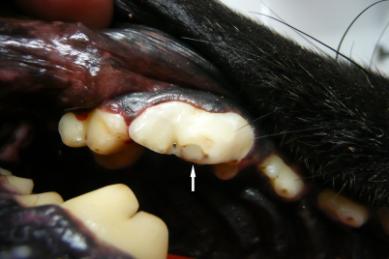See our latest leaflet on tooth trauma (click here)
Root Canal Treatment
Root canal treatment is used for a number of different reasons, but essentially it is used to maintain a tooth in an animals mouth, whereby that tooth would normally need to be extracted. It is the most common reason the animals are referred to our service. It is used to treat damaged and devitalised teeth and may be used to treat dogs with malocclusions, where an abnormally positioned tooth is causing damage to other structures, such as other teeth or soft tissues within the mouth. It is not used in veterinary medicine as a cosmetic procedure, but is mainly used to preserve those teeth which we prefer not to remove. Some teeth, such as the maxillary and mandibular canine teeth, the mandibular 1st molar and the maxillary 4th pre-molar, have both structural and functional significance, and extraction of these teeth usually requires a significant surgical procedure which can result in post operative discomfort. For example, the mandibular canine teeth have a root that is approximately twice the length of the crown visible in the mouth (sometimes 40+mm in length) with a diameter than can account for 80-90% of the thickness of the mandible in this area. Extraction therefore is not only an incredibly uncomfortable procedure, but also has the potential to significantly weaken the lower jaw in that area and make it susceptible to jaw fractures here.
Above: Complicated (pulp exposed) crown fracture of left mandibular canine tooth
Right: Arrow shows a periapical lesion which has resulted from pulp necrosis following a crown fracture in a maxillary canine tooth

Root canal treatment of teeth is an elegant and minimally invasive technique that not only results in an immediate, pain-free tooth at the end of the procedure. It allows a tooth that is otherwise dead, to remain in the animals mouth, maintaining its structure and function and avoiding a painful extraction of a large tooth.
To carry out a root canal treatment we need to clean out the inside part of the tooth where the vital structures such as nerves and blood vessels are or were before the tooth became devitalised. In devitalised teeth, where the tooth as been 'dead' for a period of time, the pulp chamber is full of black, foul smelling material. The canal is shaped and cleaned out using a combination of filing, with long thin files that sequentially increase in size; and flushing with sodium hypochlorite (bleach).
Above: A collection of veterinary length endodontic files
Right: A radiograph of an endodontic file in place within the root canal of a maxillary canine tooth

Once the tooth has been adequately cleaned out, the pulp is filled up with an inert material. Then a 'final restoration' of a material which is similar in colour to the enamel is placed in the openings of the pulp to seal the tooth from saliva and bacteria normally present within the oral cavity. The final appearance of the tooth is more or less the same as the shape of the tooth before the procedure. The procedure is carried out under general anaesthesia and is usually carried out in a single stage, although sometimes, depending on the inflammation within the tooth, the procedure is carried out in 2 stages. The animals recover well and are usually discharged then same day. We always recall patients 6 months after their initial treatment to repeat xrays of the tooth and its surrounding structures to ensure that the original injury is healing well. The procedure is very succussful, with failure rates of less than 5%, which is very low.


Above: Arrow showing the final restoration following root canal treatment in a maxillary 4th premolar tooth
Left: Final obturation of a mandibular canine tooth following root canal treatment
If your pet has a fractured or devitalised tooth and you would like one of our vets to assess them for root canal treatment then please contact us to arrange an appointment. If your pet is already being treated by a veterinary surgeon, then please discuss with them arranging a referral to us. We are happy to take clients from all over the country, but we generally cover the south and south west of England.